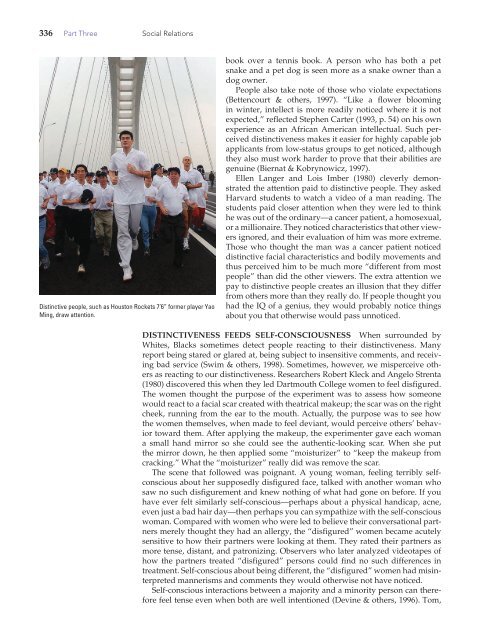Chapter 9: Prejudice: Disliking Others (2947.0K) - Bad Request
Chapter 9: Prejudice: Disliking Others (2947.0K) - Bad Request
Chapter 9: Prejudice: Disliking Others (2947.0K) - Bad Request
Create successful ePaper yourself
Turn your PDF publications into a flip-book with our unique Google optimized e-Paper software.
336 Part Three Social Relations<br />
Distinctive people, such as Houston Rockets 7’6” former player Yao<br />
Ming, draw attention.<br />
book over a tennis book. A person who has both a pet<br />
snake and a pet dog is seen more as a snake owner than a<br />
dog owner.<br />
People also take note of those who violate expectations<br />
(Bettencourt & others, 1997). “Like a flower blooming<br />
in winter, intellect is more readily noticed where it is not<br />
expected,” reflected Stephen Carter (1993, p. 54) on his own<br />
experience as an African American intellectual. Such perceived<br />
distinctiveness makes it easier for highly capable job<br />
applicants from low-status groups to get noticed, although<br />
they also must work harder to prove that their abilities are<br />
genuine (Biernat & Kobrynowicz, 1997).<br />
Ellen Langer and Lois Imber (1980) cleverly demonstrated<br />
the attention paid to distinctive people. They asked<br />
Harvard students to watch a video of a man reading. The<br />
students paid closer attention when they were led to think<br />
he was out of the ordinary—a cancer patient, a homosexual,<br />
or a millionaire. They noticed characteristics that other viewers<br />
ignored, and their evaluation of him was more extreme.<br />
Those who thought the man was a cancer patient noticed<br />
distinctive facial characteristics and bodily movements and<br />
thus perceived him to be much more “different from most<br />
people” than did the other viewers. The extra attention we<br />
pay to distinctive people creates an illusion that they differ<br />
from others more than they really do. If people thought you<br />
had the IQ of a genius, they would probably notice things<br />
about you that otherwise would pass unnoticed.<br />
DISTINCTIVENESS FEEDS SELF-CONSCIOUSNESS When surrounded by<br />
Whites, Blacks sometimes detect people reacting to their distinctiveness. Many<br />
report being stared or glared at, being subject to insensitive comments, and receiving<br />
bad service (Swim & others, 1998). Sometimes, however, we misperceive others<br />
as reacting to our distinctiveness. Researchers Robert Kleck and Angelo Strenta<br />
(1980) discovered this when they led Dartmouth College women to feel disfigured.<br />
The women thought the purpose of the experiment was to assess how someone<br />
would react to a facial scar created with theatrical makeup; the scar was on the right<br />
cheek, running from the ear to the mouth. Actually, the purpose was to see how<br />
the women themselves, when made to feel deviant, would perceive others’ behavior<br />
toward them. After applying the makeup, the experimenter gave each woman<br />
a small hand mirror so she could see the authentic-looking scar. When she put<br />
the mirror down, he then applied some “moisturizer” to “keep the makeup from<br />
cracking.” What the “moisturizer” really did was remove the scar.<br />
The scene that followed was poignant. A young woman, feeling terribly selfconscious<br />
about her supposedly disfigured face, talked with another woman who<br />
saw no such disfigurement and knew nothing of what had gone on before. If you<br />
have ever felt similarly self-conscious—perhaps about a physical handicap, acne,<br />
even just a bad hair day—then perhaps you can sympathize with the self-conscious<br />
woman. Compared with women who were led to believe their conversational partners<br />
merely thought they had an allergy, the “disfigured” women became acutely<br />
sensitive to how their partners were looking at them. They rated their partners as<br />
more tense, distant, and patronizing. Observers who later analyzed videotapes of<br />
how the partners treated “disfigured” persons could find no such differences in<br />
treatment. Self-conscious about being different, the “disfigured” women had misinterpreted<br />
mannerisms and comments they would otherwise not have noticed.<br />
Self-conscious interactions between a majority and a minority person can therefore<br />
feel tense even when both are well intentioned (Devine & others, 1996). Tom,

















